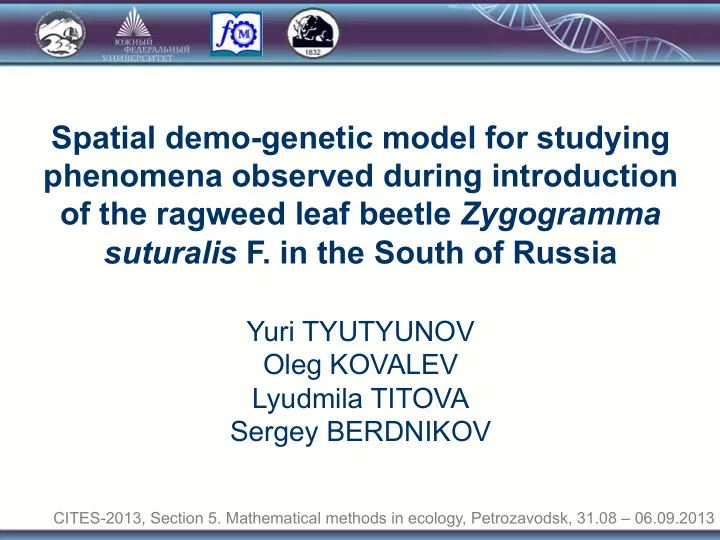

Spatial demo-genetic model for studying phenomena observed during introduction of the ragweed leaf beetle Zygogramma suturalis F. in the South of Russia Yuri TYUTYUNOV Oleg KOVALEV Lyudmila TITOVA Sergey BERDNIKOV CITES-2013, Section 5. Mathematical methods in ecology, Petrozavodsk, 31.08 – 06.09.2013
2 History of biological system Ambrosia artemisiifolia L. Zygogramma suturalis F. Dr.Sc. Oleg V. KOVALEV XVIII-XIX – Europe 1978 – Stavropol Krai (ZIN RAS, St. Petersburg) 1910 th – South of Russia 1984 – North Caucasus Author of the biological 1940 th – outbreak in SU 1986 – Palearctics method for suppression 1980 th – modern period of common ragweed
3 Observed phenomena � Solitary population wave (SPW) of the ragweed leaf beetle population Helicopter view of SPW front (Kovalev, Vechernin 1986, 1989; Kovalev 2004)
4 Observed phenomena � Rapid (within 5-6 years) development of flight of the ragweed leaf beetle Changes in axillary apparatus including development of wing muscles and axillary sclerites Flying subspecies Zygogramma suturalis (Kovalev 1989; Brodsky 1989; volatus Kovalev (Kovalev 1989; Kovalev 2004) Kovalev 2004; Arzanov 2012)
5 Specific demands to the model Explicit description of spatial dynamics � Considering both random (diffusion) and active directed � movements of phytophage population density, stimulated by heterogeneity of food resource (trophotaxis) Accounting for spatial heterogeneity by marking plots unfit for � vegetation Ability to keep track of changes in genetic structure of � phytophage population Accounting for the Allee effect (Allee 1931; Stephens, � Sutherland, 1999) in phytophage population Universality, applicability to broad class of similar systems � We combine explicit modelling of animal spatial behaviour (Govorukhin et al 2000; Arditi et al 2001; Tyutyunov et al 2002; 2009; Sapoukhina 2003) with demogenetic equations of V.A. Kostitzin (1936; 1937; 1938; 1938a)
6 Spatial demo-genetic model
7 Simulations COMMON NON-FLYING ALLELE TEMPORAL RAGWEED BEETLES FREQUENCIES DYNAMICS DENSITY CULTURAL FLYING FLIGHT PHASE PLANT BEETLES ALLELE TRAJECTORY DENSITY
8 Supplementary simulations Without Allee effect ( A =0) à flight evolution is negligibly slow � Homogeneous release of beetles à no SPW and à no control � Lowering weed growth decreases SPW effect of weed control � In order to elucidate the factors that determine Extremely low production of ragweed à beetles can't establish � efficiency of biomethod and accelerate the Increased habitat fragmentation à ‘walkers’ replace ‘flyers’ � evolution in the model, additional simulations have been performed.
9 Conclusions Model correctly reproduces qualitative dynamics of the system � Phytopage SPW is a key factor of biomethod efficiency � SPW accelerated development of flight of Z. suturalis in Russia � SPW formation requires plots with high ragweed density � SPW enhances the excluding effect of the competing plant � Cultural plants prolongate SPW effect of weed extermination �
Thank you for attention!
Recommend
More recommend